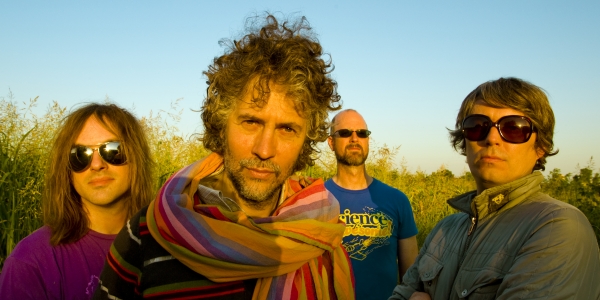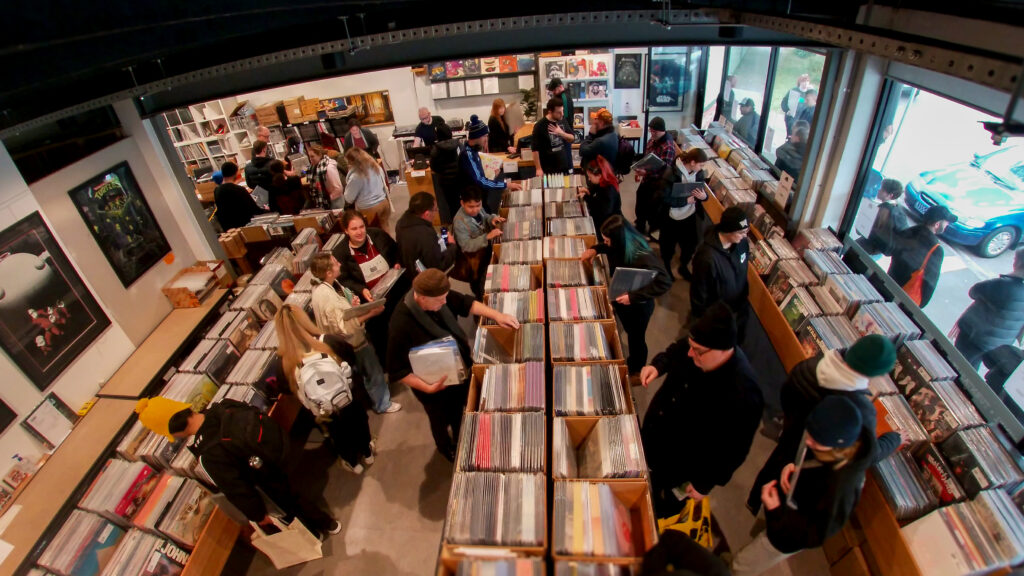“It was all very helpful and allowed us to really accelerate ourselves, and do not just a lot of music, but a lot of conceptual art, which is really what being a band is about. We’ve always done that, it’s just that previous to this time we always were limited to how many things we could put out, by contracts and publishing deals and all these things. So I think that freedom made us, just… fucking freak out.”
“Freak out” seems about right. How else could one describe the mad rush of releases that The Flaming Lips have pumped out over the past two years? There was the six-hour single, collaborations with everyone from Yoko Ono through to Ke$ha (the vinyl versions of which were pressed with human blood, naturally), a 24-hour track limited to 13 copies encased in actual human skulls, a studio re-recording of the entire Dark Side Of the Moon album, a series of USB drive releases embedded in gummy fetuses and brains, Guinness World Record attempts and numerous other off-the-wall experiments which all made it seem as if The Flaming Lips would never again sit still for long enough to record a traditional album.
Not that they needed to. Across 12 studio albums, the band had traversed every conceivable sonic terrain, with moments of heartbreaking beauty rubbing up against acid-inspired noise-jams, folk songs and twisted pop gems. 1999’s transcendent sonic left-turn The Soft Bulletin and 2001’s death-obsessed Yoshimi Battles The Pink Robots are routinely placed in the higher reaches of Best Album Ever lists, and 1993’s She Don’t Use Jelly briefly saw the band enter the world of singles charts and MTV rotation – as well as a cameo on 90210, which they accepted gleefully.
“We were like, ‘Fuck yeah, we’ll do it.’ Because it’s ridiculous, and it can be fun, and we didn’t think that would damage us artistically,” Coyne recalls. 1997’s Zaireeka – four CDs designed to be played simultaneously – quickly stymied such scenarios. So, with such a definitive string of albums and the post-label madness that followed, it came as some surprise to learn that the band had completed their thirteenth full-length record: a dense, intense collection titled The Terror.
“We started to make music this way, which is a bit dissonant, even amongst itself,” Coyne explains. “The music within the song doesn’t always lineup and it’s not always in tune and it’s kind of purposefully got this untamed-ness about it. We started doing some of that on the last record [2009’s sprawling, scattershot Embryonic], and there’s been moments of it all along, but we didn’t choose to do it as relentlessly as we are choosing to do it now.” For those more familiar with the joyous strains of Do You Realize?? or the celestial ceremony of Race For The Prize, the unsettling rush of The Terror may come as a shock. Coyne insists it’s all part of pushing forward, and none of this experimentation constitutes the band ignoring their past.
“We’re just exploring other dimensions of our character I think. When we hear music like Do You Realize?? and Yoshimi…, we don’t go, ‘Oh my God, that’s not us’ – we are all that. That probably goes against what an artist is supposed to be: totally self-absorbed, in the moment, if we love this music, we hate that music. We can easily write the saddest, bleakest, darkest music, then next to it play something very happy and major-chord-sounding.
“We know that we’ve made records like Do You Realize?? and we don’t feel like we need to make them anymore. Do You Realize?? is still part of our character: I’m glad it is, I want it to be. [The Terror] is also part of our character, but we’re still discovering it. We’re still becoming it.”
Part of this exploration included a number of warped pre-Terror collaborations with Erykah Badu, Biz Markie, Yoko Ono (“Absolutely the real deal. I can see why someone like John Lennon would want to be around her”), Bon Iver and Ke$ha. Of course, working with such a motley crew made for wildly differing experiences, but none as divergent as the two Australian artists the band worked with: Kevin Parker of Tame Impala, and Nick Cave.
“Kevin is so gentle and so easy and so fun. He’s so laidback, he probably didn’t care what we did. He knew we were gonna make it good. Nick Cave was a little bit different than that,” Coyne laughs. “You have to do it a little bit on his own time, and he’s not so ‘anything goes’. When I asked if he’d do some music he said, ‘Well, we can only do it if we hurry, ‘cause I’ve got things to do’, so I’d send him a few things: ‘Oh, I don’t like that. Send me something else.’ So, radically different people, but both very cool, very intense. I love working with intense people. That’s why we do it. We want to be right there with them.”
BY NATHAN JOLLY







